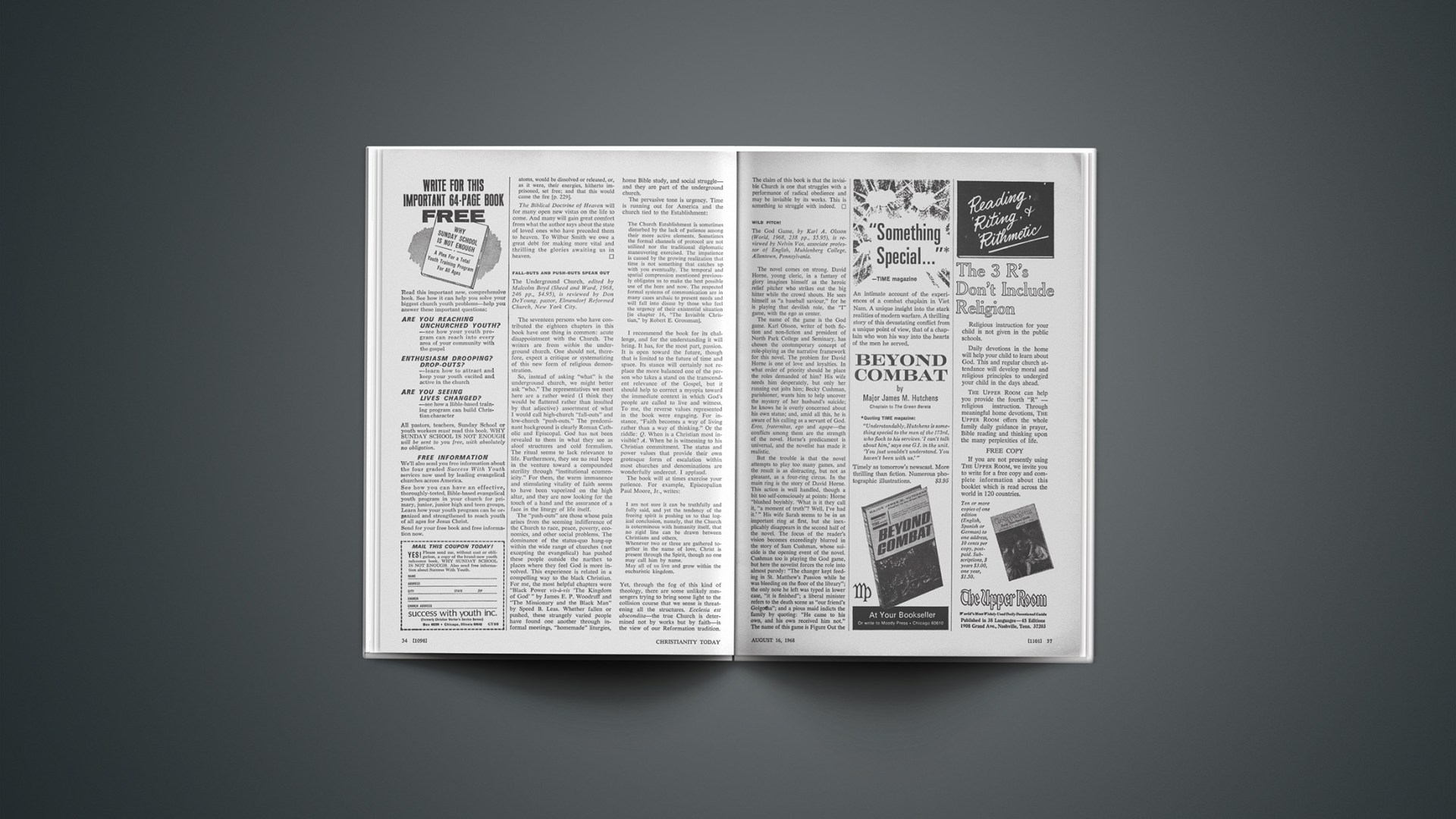Literature That Lives On
A Reader’s Guide to Religious Literature, by Beatrice Batson (Moody, 1968, 114 pp., $3.95, paper $2.95), is reviewed by Thomas Howard, teacher of English, St. Bernard’s School, New York, New York.
“What actually makes a work live as literature is a vividness and depth of perception in presenting honestly and realistically the conflicts, dilemmas and experiences of life.” This statement from the preface of this book does two things: it gives us the criterion by which Dr. Batson chose works from the almost infinite number of “God-oriented” works in Western history since the first century, and it articulates for us the principle that is the watershed between worthy and mediocre literature, whether religious or non-religious.
What makes some pieces of writing last, and others molder? Why are some works worth keeping alive in a book like this? Talent, for one thing: the ability to say the thing well. It is the simplicity as much as any observable complexity that beguiles us about things well done and fools us into believing that we could do as well. We can all see that an excellent table is excellent, and, if it is not intricately carved or painted, we might think we could make one, too. It is the same with works of literature: if we take any given phrase apart, there is nothing particularly new or unknown to us in it. All the words are in our vocabulary. The author has not done anything that we could not have done, we think. But the rub comes when we try to equal his work. Talent is an elusive thing.
But prior to talent is the vision that sees things that are worth saying. It is this “vividness and depth of perception” of which Dr. Batson speaks. It is greatness of imagination, that is, the ability to see the antiphonal relationships that exist among all the data of experience (what T. S. Eliot called seeing the fear in a handful of dust), so that the plain stuff of daily life becomes a paradigm of the eternal.
This kind of talent and vision is exhibited in all worthy literature. The writer (the great writer, I mean) always addresses himself to what he sees to be the truth of the matter. And since the first century there have been many writers whose notion of the truth of the matter has been Christian, and who have addressed themselves to human experience in these terms. This book is a guide to the works of the greatest of these writers.
It is both a reference work and a book you can read through with pleasure. It is scholarly, thorough, and systematic, but not plodding. It is descriptive rather than critical; you may find out what a work is all about, but you are not told why the author gives it a place in the canon of good literature. The study is organized in the logical way, according to the periods generally used in the description of literature: the Middle Ages and the Renaissance, including Augustine, Dante, Kempis, early drama, and the mystics; the seventeenth century, with studies of Herbert, Vaughan, Crashaw, Browne, Bunyan, Taylor, and others, and extensive studies of John Donne and Milton; the eighteenth century, including Cowper and Law, as well as a number of American writers; the nineteenth century, with Newman, Hawthorne, Browning, Hopkins, and others. The twentieth century presents special problems to today’s critic and historian of literature, for he can never be sure which works will last. Dr. Batson has done the only thing possible, which is to include the writers whose works have so far seemed the most significant: Eliot, Mauriac, Auden. C. S. Lewis is there, too, a choice that seems obvious to Christians but that might be contested by critics who would not quarrel with the others (it is rather fashionable to tut-tut Professor Lewis).
Each chapter begins with a study of the historical and cultural context of the works included in that chapter. There are also biographical sketches of the authors. The work is fully documented in footnotes, and a helpful bibliography for further study is appended.
Dr. Batson has done a job that seems so obvious and so necessary that one wonders why it was not done before. But it was a happy delay that left the doing of it to Dr. Batson. Her trustworthy scholarship, her vigorous and economical way of summarizing, her sophisticated judgment in making the selection, and her understanding of both religious and literary canons have combined to make this an extraordinarily helpful book.
Special note to CHRISTIANITY TODAY readers: There is a great deal of discussion in the conservative Protestant wing of “Christian” literature, and a growing awareness of the cultural penury of our sort of religion. This might be an excellent book to recommend to people who wonder whether their understanding of the religion of Christ has perhaps inclined them to a less than fair appreciation of the humanistic tradition, but who boggle at the sheer unapproachability of the literary pile. If they are timorous about approaching, say, Dante, let them allow Dr. Batson to lead them, in the same way another Beatrice led Dante to realms he found intimidating.
God’S Envoy In Society
The Social Conscience of the Evangelical, by Sherwood Wirt (Harper & Row, 1967, 177 pp., $4.95), is reviewed by Robert Strain, assistant minister, Fourth Presbyterian Church, Bethesda, Maryland.
Sherwood Wirt, editor of Decision magazine, offers in this book an easy-to-read size-up of social issues to which evangelicals should address themselves. He shows how Christians have shaped Western society. Recognizing that for a hundred years evangelicals have tended to neglect the homeland in favor of foreign missions, Wirt searches for ways to activate evangelical social concern. In his search he gives due attention to precedents set by churchmen of the past.
Wirt realizes that today’s evangelical has a real hang-up about duty on the social scene. But why? Redemption, both temporal and eternal, emanates from Jesus Christ, and Christ’s representatives ought to be the ones supplying answers in our cultural crises. If evangelical Christians shaped society in generations gone by, why are they not doing so today? Faith and works must once again be found in the same package.
History shows extensive evangelical involvement in the social realm. Zwingli provided bread for the poor of Zürich. Wilberforce in the British Parliament helped rid his nation of slavery. John Eliot, New England schoolteacher and pastor, demonstrated the social side of the Gospel in his work with the Indians. Finney in Ohio hid the fugitive slaves who came through town. The same social concern characterized the lives of such men as Morrison of China, Livingstone of Africa, and Gilmour of Mongolia—as well as Moses, Amos, Hosea, Isaiah, Micah, Jeremiah, James, and John the Baptist. All these persons had two things in common: evangelistic fervor and an active social conscience. Today’s evangelicals must not surrender to religious liberals the “good works” dimension, which sprang from the message and impact of evangelical revival.
Wirt claims that the big reason for social rigor mortis in evangelicals of the 1960s is confusion. He writes:
To sum up, the evangelical emerges from his Rip Van Winkle sleep to find that the issues are already being defined for him. Even as he opens his Bible and draws on the Scriptural resources that are available, he is tossed on the horns of a dilemma. For if he chooses one position, he chances being branded as a Himmler-type reactionary; but if he chooses the opposite, he risks being herded with atheistic pinks and homosexuals. If he proposes to make the Bible his touchstone and guide, he is engulfed by a torrent of literature purporting to show that the Bible’s social teaching sanctions everything from state lotteries and genocide to ship-picketing, blood donations to the Viet Cong, and tossing Molotov cocktails at heads of state. If he withdraws to seek the witness of the Spirit and the whole counsel of God, he is cited as a quietist and obscurantist. Hyperactive churchmen hold him up as an example of irrelevance of faith to works.
Church and state power structures, poverty in the land, highway safety, capital punishment, abortion, euthanasia, unnatural sex, alcohol, and dope—these major problems that evangelical churches have not seen as their own press hard for solutions. The evangelical must decide whether he will act as God’s envoy or live in air-conditioned isolation.
Wirt’s evangelical is a healthy, well-balanced man. His only real problem is noble inertia. He is bewildered, and wonders where he can take hold at this late hour. Wirt reminds him that Jesus came not to split theological hairs but to minister to a world of need and to save men out of it for eternity. He writes: “Capture a man for Christ, and in the evangelical view as he grows in faith his usefulness increases. His integrity becomes established and he becomes a dependable center of influence for good.” The answer still is God’s reconciling love in Christ. This book seeks to move reconciled men to lives of action-packed love.
Here is great reading for the general Christian public, though a serious student of social issues may find it rather simple. Its social critique sometimes lacks sharp teeth, but it is nonetheless the best discussion of Christian action I have read. Many evangelicals will find that it accurately diagnoses their problem and points them to a responsible solution.
New Vistas Of Heaven
The Biblical Doctrine of Heaven, by Wilbur M. Smith (Moody, 1968, 317 pp., $4.95), is reviewed by Henry W. Coray, minister, Calvary Orthodox Presbyterian Church, Glenside, Pennsylvania.
Dr. Wilbur Smith, professor emeritus of Trinity Evangelical Divinity School, is a great bibliophile. In this extensive study of the doctrine of heaven, he includes quotations from some 160 authors. Almost every page flashes a jewel from one of the masters, such as Augustine, Baxter, John Brown, Calvin, Goodwin, Whately, and Whyte. Dr. Smith is at home with modern expositors as well. But as one would expect from a biblical theologian, the Scripture, from which he cites 850 pertinent passages, is the basis for this solid piece of scholarship.
Smith presents helpful treatments of such absorbing topics as “Heaven—the Abode of God,” “The Intermediate State,” “Occupations of the Redeemed in Heaven,” and “New Heavens and a New Earth.” While not exhaustive, the development of these subjects is not at all shallow. At the same time, Smith is healthily undogmatic on many texts where sound expositors show exegetical gaps and differences of conclusion.
Of interest to many will be his comments on the catastrophic purging of the new heavens and the new earth. Smith suggests that the language of Peter (2 Pet. 3:10) seems to coincide with the idea of the release of atomic energy by the fission of the nucleus:
Reading For Perspective
CHRISTIANITY TODAY’S REVIEW EDITORS CALL ATTENTION TO THESE NEW TITLES:
• Grace Is Not a Blue-Eyed Blond, by R. Lofton Hudson (Word, $3.95). A lively and creative look at concepts that pertain to personal predicaments of people today: grace, sin, friendship, temptation, forgiveness, love, faith, guts.
• Christianity and the World of Thought, edited by Hudson T. Armerding (Moody, $5.95). An evangelical “brain trust” brings biblical convictions and broad scholarship to bear on contemporary issues in sixteen areas of study.
• A Leopard Tamed, by Eleanor Vandevort, with an introduction by Elisabeth Elliot (Harper & Row, $5.95). A Presbyterian missionary presents an honest account of thirteen years of service in the Sudan, highlighted by her friendship with Kuac, a small boy who became a minister.
What I am getting at is that when Peter said that at the end of this entire age there would be a great conflagration of the heavens and the earth, he expressed it in language that implied that the elementary particles of matter, which we call atoms, would be dissolved or released, or, as it were, their energies, hitherto imprisoned, set free; and that this would cause the fire [p. 229].
The Biblical Doctrine of Heaven will for many open new vistas on the life to come. And many will gain great comfort from what the author says about the state of loved ones who have preceded them to heaven. To Wilbur Smith we owe a great debt for making more vital and thrilling the glories awaiting us in heaven.
Fall-Outs And Push-Outs Speak Out
The Underground Church, edited by Malcolm Boyd (Sheed and Ward, 1968, 246 pp., $4.95), is reviewed by Don DeYoung, pastor, Elmendorf Reformed Church, New York City.
The seventeen persons who have contributed the eighteen chapters in this book have one thing in common: acute disappointment with the Church. The writers are from within the underground church. One should not, therefore, expect a critique or systematizing of this new form of religious demonstration.
So, instead of asking “what” is the underground church, we might better ask “who.” The representatives we meet here are a rather weird (I think they would be flattered rather than insulted by that adjective) assortment of what I would call high-church “fall-outs” and low-church “push-outs.” The predominant background is clearly Roman Catholic and Episcopal. God has not been revealed to them in what they see as aloof structures and cold formalism. The ritual seems to lack relevance to life. Furthermore, they see no real hope in the venture toward a compounded sterility through “institutional ecumenicity.” For them, the warm immanence and stimulating vitality of faith seems to have been vaporized on the high altar, and they are now looking for the touch of a hand and the assurance of a face in the liturgy of life itself.
The “push-outs” are those whose pain arises from the seeming indifference of the Church to race, peace, poverty, economics, and other social problems. The dominance of the status-quo hang-up within the wide range of churches (not excepting the evangelical) has pushed these people outside the narthex to places where they feel God is more involved. This experience is related in a compelling way to the black Christian. For me, the most helpful chapters were “Black Power vis-à-vis ‘The Kingdom of God’ ” by James E. P. Woodruff and “The Missionary and the Black Man” by Speed B. Leas. Whether fallen or pushed, these strangely varied people have found one another through informal meetings, “homemade” liturgies, home Bible study, and social struggle—and they are part of the underground church.
The pervasive tone is urgency. Time is running out for America and the church tied to the Establishment:
The Church Establishment is sometimes disturbed by the lack of patience among their more active elements. Sometimes the formal channels of protocol are not utilized nor the traditional diplomatic maneuvering exercised. The impatience is caused by the growing realization that time is not something that catches up with you eventually. The temporal and spatial compression mentioned previously obligates us to make the best possible use of the here and now. The respected formal systems of communication are in many cases archaic to present needs and will fall into disuse by those who feel the urgency of their existential situation [in chapter 16, “The Invisible Christian,” by Robert E. Grossman],
I recommend the book for its challenge, and for the understanding it will bring. It has, for the most part, passion. It is open toward the future, though that is limited to the future of time and space. Its stance will certainly not replace the more balanced one of the person who takes a stand on the transcendent relevance of the Gospel, but it should help to correct a myopia toward the immediate context in which God’s people are called to live and witness. To me, the reverse values represented in the book were engaging. For instance, “Faith becomes a way of living rather than a way of thinking.” Or the riddle: Q. When is a Christian most invisible? A. When he is witnessing to his Christian commitment. The status and power values that provide their own grotesque form of escalation within most churches and denominations are wonderfully undercut. I applaud.
The book will at times exercise your patience. For example, Episcopalian Paul Moore, Jr., writes:
I am not sure it can be truthfully and fully said, and yet the tendency of the freeing spirit is pushing us to that logical conclusion, namely, that the Church is coterminous with humanity itself, that no rigid line can be drawn between Christians and others.
Whenever two or three are gathered together in the name of love, Christ is present through the Spirit, though no one may call him by name.
May all of us live and grow within the eucharistic kingdom.
Yet, through the fog of this kind of theology, there are some unlikely messengers trying to bring some light to the collision course that we sense is threatening all the structures. Ecclesia est abscondita—the true Church is determined not by works but by faith—is the view of our Reformation tradition. The claim of this book is that the invisible Church is one that struggles with a performance of radical obedience and may be invisible by its works. This is something to struggle with indeed.
Wild Pitch!
The God Game, by Karl A. Olsson (World, 1968, 238 pp„ $5.95), is reviewed by Nelvin Vos, associate professor of English, Muhlenberg College, Allentown, Pennsylvania.
The novel comes on strong. David Horne, young cleric, in a fantasy of glory imagines himself as the heroic relief pitcher who strikes out the big hitter while the crowd shouts. He sees himself as “a baseball saviour,” for he is playing that devilish role, the “I” game, with the ego as center.
The name of the game is the God game. Karl Olsson, writer of both fiction and non-fiction and president of North Park College and Seminary, has chosen the contemporary concept of role-playing as the narrative framework for this novel. The problem for David Horne is one of love and loyalties. In what order of priority should he place the roles demanded of him? His wife needs him desperately, but only her running out jolts him; Becky Cushman, parishioner, wants him to help uncover the mystery of her husband’s suicide; he knows he is overly concerned about his own status; and, amid all this, he is aware of his calling as a servant of God. Eros, fraternitas, ego and agape—the conflicts among them are the strength of the novel. Horne’s predicament is universal, and the novelist has made it realistic.
But the trouble is that the novel attempts to play too many games, and the result is as distracting, but not as pleasant, as a four-ring circus. In the main ring is the story of David Horne. This action is well handled, though a bit too self-consciously at points: Horne “blushed boyishly. ‘What is it they call it, “a moment of truth”? Well, I’ve had it.’ ” His wife Sarah seems to be in an important ring at first, but she inexplicably disappears in the second half of the novel. The focus of the reader’s vision becomes exceedingly blurred in the story of Sam Cushman, whose suicide is the opening event of the novel. Cushman too is playing the God game, but here the novelist forces the role into almost parody: “The changer kept feeding in St. Matthew’s Passion while he was bleeding on the floor of the library”; the only note he left was typed in lower case, “it is finished”; a liberal minister refers to the death scene as “our friend’s Golgotha”; and a pious maid indicts the family by quoting: “He came to his own, and his own received him not.” The name of this game is Figure Out the Christ Figure. In the final ring is Becky Cushman, wealthy, wily widow, who persuades Horne to attempt to penetrate the mystery of her husband’s death.
The people he meets on his Conradian journey are fantastic, if not a defiance of Aristotelian probability: a folksy, golf-playing M.D. who seems intimately familiar with the letters St. Jerome wrote to women, a hard-driving executive who becomes violently drunk by guzzling Old Crow from a pure violet plastic glass, and a small-town Southern Baptist preacher who quotes Emerson, Graham Greene, and Swinburne while the Klan is threatening his home. And instead of the climactic revelation that the Baptist minister, as former chaplain to Cushman, is expected to convey, the focus is on a miscegenation affair that the minister himself had in his youth. Some readers are apt to get lost.
Perhaps the basic difficulty is that the novelist is playing too many styles in a single game. One style is melodrama: “ ‘Go on,’ he said with a tense smile. ‘Nothing will mean anything until I’ve heard the story.’ ” Another is satire, found particularly in the Waugh-Huxley-like tour of Cushman’s plastic factory, in which an inspector says: “Cleanliness is godliness at Dynaplast.” And, finally, in refreshing deviation from the old-fashioned religious novel, there is earthy, blunt realism: “You get the Hell out. Get your fat reverend butt out of here.…” The lack of tonal unity frequently flaws the narrative.
Mr. Olsson has the ear and the eye of a novelist: “Across the road were the tangerine battlements of a Howard Johnson’s”; the minister’s wife sputters that “ministers have got to be divinity. The most disagreeable candy I know is something called divinity—the sweet, smooth droppings of the dove of peace.” But what it seems necessary to add is that in the game called novel-writing, one mandate seems central: Control the ball!
Lost And Found
Where You Find God, by Walter Russell Bowie (Harper & Row, 1968, 116 pp., $3.95), is reviewed by Ronald B. Rice, chaplain, Whitworth College, Spokane, Washington.
In the aftermath of the “God is dead” movement, Bishop Robinson’s questioning of the traditional conceptions of God, Dietrich Bonhoeffer’s “religionless Christianity,” and Paul Tillich’s concept of God as the “Ground of Being,” amid increasing vagueness and ambiguity about the existence and nature of God, comes Dr. Bowie’s stimulating and helpful book. Writing for the layman and certainly for the pastor, Bowie grapples with the ways to find God in one’s own life. He attempts to speak in a new idiom to the man who has rejected the Church and a message he considers tradition bound, cliché ridden, and out of date. Where You Find God is a refreshing and commendable effort to couch a fairly traditional view of God and of Christ in terms that speak to modern secular man.
“Most people who have been brought up religiously are not going to swallow the raw assertion that ‘God is dead,’ ” Bowie observes. “But they do get vastly troubled when they try to find some answer to their wondering as to what he may be and where he may be found.… The person who has supposed that he already had a religious faith that was sufficient may discover that it was built on foundations which are sinking under him.” It is to this man that the book is directed.
“Human souls that have tasted life most fully will not be persuaded that a ‘secular meaning of the Gospel’ is enough: that we can get along without any transcendent Lord and work out our own salvation—or maybe find out that there is none,” the author concludes after a close and readable look at much of the contemporary debate about the nature and existence of God and the Incarnation.
Where You Find God finds God “In the Intensity of Life,” as “The Presence Back of History,” through the “Changing Thought and Unchanging Reality” of the Incarnation, and as “The Experienced Reality” in human life. In a brief look at the faith of Dag Hammarskjöld, Bowie concludes his book with a crucial observation about the life of faith in God: “The contemplative life and the active life belong together.”
Although some conservative readers will not like Bowie’s treatment of Old Testament passages, the Atonement, and some other points, the book as a whole is a valuable statement of faith in the God of Creation, the God of the Scriptures, and the Lord of History. It will be most helpful to the modern man previously described, or to the pastor who speaks to him.
Is Hargis’S Crusade Christian?
The American Far Right, by John H. Redekop, (Eerdmans, 1968, 232 pp., $4.50), is reviewed by William R. Harrison, lieutenant general (retired), United States Army, Largo, Florida.
John H. Redekop has given us a careful, objective, and well-documented analysis of the political far right as represented by the Rev. Billy James Hargis. It is recommended for anyone—particularly the Bible-believing Christian—who is concerned over political trends in the United States.
Redekop feels that Hargis is sincere and honest, and that his ideological position is a variant of the traditional conservatism held by many Americans since the founding of the nation. Hargis is not a racist, says the author, and advocates only peaceful and legal methods of political action.
According to Redekop’s fully documented findings, Hargis is a biblical fundamentalist, believing in the divine inspiration and authority of the Bible. He apparently believes that the country was founded by true Christians and has remained a Christian country ever since. In fact, he practically identifies Christianity with nationalistic Americanism, claiming that in a special sense the United States is God’s country, corresponding to ancient Israel. He is opposed to liberalism in both religion and social matters and leans toward a laissez-faire social system. He advocates no positive action by which the people as a whole, acting through their government, may try to alleviate the troubles of the poor and needy. He is governed by strong feelings of anti-Communism. Redekop writes, “Ultimately, Hargis’s anti-Communism is out of joint with the Christian faith of which it claims to be a part, for in its positive assertions, it is frequently an idolatrous faith in a man-made culture.” In all this, Hargis is firmly convinced that he is fighting God’s battle.
I too believe firmly in the plenary inspiration and authority of the Bible as the Word of God, to be believed and obeyed. My study and experience lead me to be against Communism and to consider the Soviet Union’s imperialism a dangerous threat to the security of the United States. But if the facts Redekop presents are correct, I cannot but feel that Hargis’s Christian Crusade is not at all consistent with the Bible, and that it identifies God with his own preferred national culture. He makes his fight against liberalism, socialism, and Communism a substitute for the Gospel of Christ in the same way that many religious liberals do with the social gospel.
By contrast, Christ’s kingdom in this present age is not of this world; neither is he redeeming the world. He came into the world, died for men’s sins, and rose again from the dead so that individual men through faith in him could be forgiven and reconciled to God. God is taking out of mankind a people for his name (Acts 15:14). As a warning of ultimate judgment, he has given men over to those personal moral evils that cause most of the social troubles in the world (Rom. 1:18–32). The liberals’ optimistic belief that they can cure the world’s ills is totally unjustified.
Nevertheless, every reasonable and legitimate effort to alleviate the problems of the poor, the needy, and the persecuted is fully in accord with Christ’s compassion. The primary mission of the individual Christian and the Church is to be a faithful witness to the world that Christ saves from sin. A person’s own life is the best testimony to the truth of his verbal witness, if he is obedient to the biblical injunction that he should love his neighbors and do good to all men. Doing good certainly may include corporate action by the citizens, that is, through government and other bodies, even though such action will not bring in the millennium. I cannot but feel that the Christian Crusade is not actually Christian, and that it may be as dangerous to the country as the radical left or Communism.
Book Briefs
Not Quite So Simple, by Senator Mark O. Hatfield (Harper & Row, 1968, 302 pp., $6.95). The popular senator from Oregon, an evangelical Christian, reviews his academic and government careers and sets forth his political views, particularly his dovish position on the Viet Nam war.
While Six Million Died, by Arthur D. Morse (Random House, 1968, 420 pp., $6.95). On the basis of extensive reresearch, Morse upbraids the United States government for its apathetic response to Hitler’s acts of genocide against the Jews.
Four Religions of Asia, by Herbert Stroup (Harper & Row, 1968, 212 pp., $6). A primer on Hinduism, Jainism, Buddhism, and Sikhism.
The Real and Only Life, by Nancy Peer-man (Word, 1968, 102 pp., $3.95). A housewife’s testimony of her Christian faith.
God’s Program of the Ages, by Frederick A. Tatford (Kregel, 1967, 160 pp., $3.50). A British scholar offers the dispensational viewpoint on prophecy—pre-tribulation rapture, pre-millennial.
Genesis, by Derek Kidner (Inter-Varsity, 1967, 224 pp., $3.95). A lucid evangelical commentary on Genesis that also provides materials of introduction and analysis and notes on special problems. From the “Tyndale Old Testament Commentaries.”
Illustrated History of the Reformation, edited by Oskar Thulin (Concordia, 1967, 328 pp., $10). A limited edition of a solid work in Reformation history that incorporates superb photographs and art work.
Operation Brother’s Brother, by Cyril E. Bryant (Lippincott, 1968, 206 pp., $4.95). The story of a dedicated servant of Christ, Dr. Robert A. Hingson, whose jet immunization gun has relieved the suffering of thousands throughout the world.










